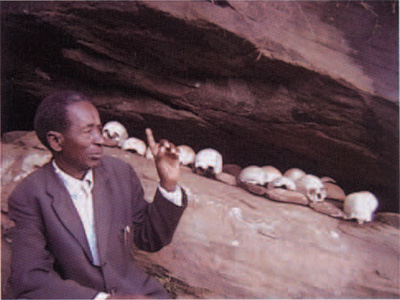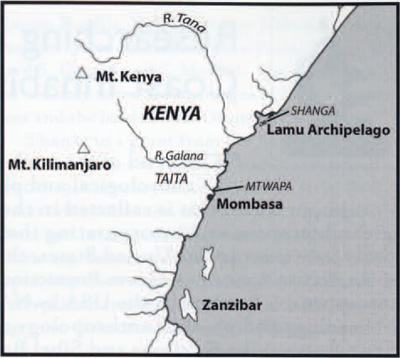
The end of the 10th century marked many changes in the way archaeological and physical anthropological research is conducted. Most importantly, this is reflected in the inclusion of indigenous peoples in the research process, and incorporating their insights, borne of their knowledge of local traditions. In the United States, this change was formalized in the passage of the Native American Grave Protection and Repatriation Act (NAGPRA). The new approach fostered in the USA by NAGPRA can be applied productively to archaeology and physical anthropology research on other continents. In a joint effort Drs. Chapurukha Kusimba and Sibel Barut of the Field Museum in Chicago and I have used the same strategy for a case study in East Africa. Our focus has been the application of biological anthropology.
In 1997, we undertook a project to analyze materials from the Swahili coastal site of Mtwapa, Kenya (north of Mombasa), and the island site of Shanga (in the Lamu archipelago). The materials, including skeletal remains, were excavated from mosque complexes or nearby environs. Traditionally, it was assumed that these materials represented non-indigenous elements of Islamic culture that had arrived via the East African coastal trade network. Further, we initially assumed this material represented not only the transfer of cultural elements but also the migration of peoples from the Middle East to Africa. To answer the question, “Who are these biological inhabitants of the East African coast?,” the skeletons were essential. Our research to this point indicates that although there is no doubt that cultural elements were transferred, it is no longer necessary to assume that biological population movements were involved as well.
Examination of the skeletons from Mtwapa and Shanga clearly shows their gross morphological affinities to the Taita, their hinterland neighbors. A large series of Taita skulls is stored at the Duckworth Laboratory at Cambridge University in England, and comparisons of these specimens with the Mtwapa and Shanga materials demonstrate a host of similarities. (The Taita skulls were removed from rockshelter shrines in 1929 by Louis Leakey.) Common biological features include the amount of projection and broadness of the face. There are cultural similarities as well, like the tendency among the peoples in this region to ritually remove the incisor teeth or to file them to a point. From these bone analyses, the ancient inhabitants of the Swahili coast appear to have been biologically most similar to the Taita and to show a cultural blend of indigenous and exogenous characteristics associated with the introduction of Islam, including a pattern of burying people facing towards Mecca.
In the spring of 1999, Chap Kusimba had an opportunity to visit the Taita region to confirm the existence and maintenance of ancestral rockshelter shrines. These shrines probably went into disuse after Christian missionary efforts in Kenya. In a series of interviews recorded on digital video, the rockshelter caretaker and village elder Jefferson Kibicho Maloti, now 80 years old, told us the history of a neighborhood enclosure in the Taita Taveta District in the village of Sungululu. He knew each skull in the shrine by name and to whom he or she was related, both the living inhabitants of the village today as well as the other individuals preserved within the shelter. At least five generations of village members are contained within this shrine and oral tradition keeps alive the personal history of each.

The Wataita, as the people are known today, appear to have arrived at their present location in the 16th century and occupied three mountain groups in the Tsavo region. They were agriculturists who supplemented what they grew by hunting wild game. In addition, sources document the extensive Wataita involvement in trade, primarily of ivory, skins, and perhaps slaves, along caravan routes to the coastal communities. These ancient trade routes also served the needs of the British colonial government. Among the many changes precipitated by European contact was the introduction of Christian mission stations into this region. In the 1920’s much of the local religious practice was subverted, at least superficially, to a Christian model. So by the late 1920s, when Louis Leakey was allowed to remove the skulls from rockshelter shrines, the traditional patterns of burial and later disinterment of skulls were thought to be defunct. Thus, in an initial visit to Ghazi, another village in the Taita region, in 1998, the Wataita were hesitant to show us the extant shrines. Only with our continued involvement in and long-term commitment to the community did the information surface.
Reliable techniques now exist for the extraction of DNA from skeletal materials, so 20 small bone samples were removed, with the help of village residents, from the rockshelter specimens. The samples will be compared to the genealogy constructed from interviews for both the living and ancient inhabitants of the village. Finally, this material will be compared to the extracted DNA from the Mtwapa/Shanga materials. Although gross bone morphology appears to suggest strong affinities to the Taita, this avenue of research will clearly demonstrate the level of genetic association or if any association exists at all.
To date, no nuclear DNA has been identified, but two of the bone samples have yielded mtDNA residues. The long and arduous analysis is being done by Dr. Joseph Lorenz at the Corolla Institute for Medical Research in Camden, New Jersey. It is our hope that the DNA analysis will confirm the findings of the study of gross anatomy of the bones, and show that the great culture of the Swahili Coast of East Africa is an outgrowth of the indigenous peoples of East Africa.
Janet Monge
Keeper. Physical Anthropology Section
